Sandmartin STT4-HDR Digital Video Broadcasting User Manual STT4 HDR V1 0
Sandmartin(Zhong Shan) Electronic Co., Ltd. Digital Video Broadcasting STT4 HDR V1 0
user manual

Receiver/Digital Decoder
DVB-C Set Top Box
Installation Manual
&
User Manual
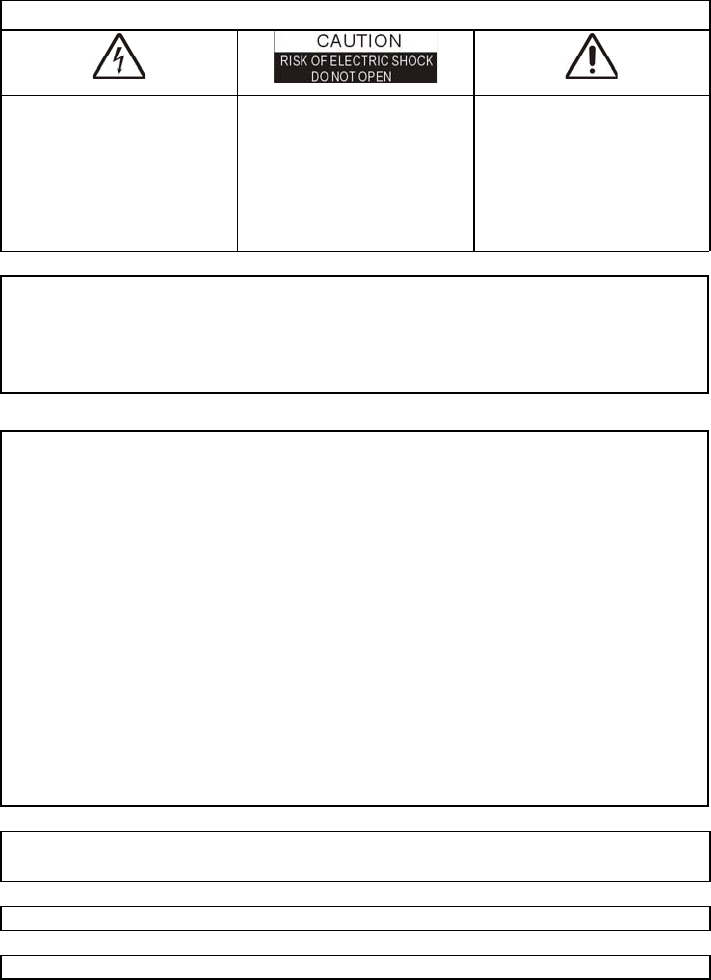
SAFETY PRECAUTION
CAUTION:
The lightning flash with
arrowhead symbol, within an
equilateral triangle, is
intended to alert the user to
the presence of "dangerous
voltage" and to prevent from
risk of electric shock.
Warning:
To reduce the risk of electric
shock, don’t open the cover
or cabinet. Refer servicing to
qualified personnel only.
The exclamation point within
an equilateral triangle is
intended to alert the user to
important operating and
maintenance (servicing).
Caution: The user is cautioned that changes or modifications not expressly approved by
the party responsible for compliance could void the user's authority to operate the
equipment.
For a Class B digital device or peripheral, the instructions furnished the user shall include
the following or similar statement, placed in a prominent location in the text of the
manual:
Note: This equipment has been tested and found to comply with the limits for a Class B
digital device, pursuant to part 15 of the FCC Rules. These limits are designed to provide
reasonable protection against harmful interference in a residential installation. This
equipment generates, uses and can radiate radio frequency energy and, if not installed
and used in accordance with the instructions, may cause harmful interference to radio
communications. However, there is no guarantee that interference will not occur in a
particular installation. If this equipment does cause harmful interference to radio or
television reception, which can be determined by turning
the equipment off and on, the user is encouraged to try to correct the interference by one
or more of the following measures:
—Reorient or relocate the receiving antenna.
—Increase the separation between the equipment and receiver.
—Connect the equipment into an outlet on a circuit different from that to which the
receiver is connected.
—Consult the dealer or an experienced radio/TV technician for help
WARNING: The STB shall not be exposed to dripping or splashing of liquids.
No objects filled with liquids, such as vases, shall be placed on the STB.
WARNING: Do not put a candle or lamp on the housing, as this can cause a risk of fire.
WARNING: The unit should be connected to a power supply only of the type described in
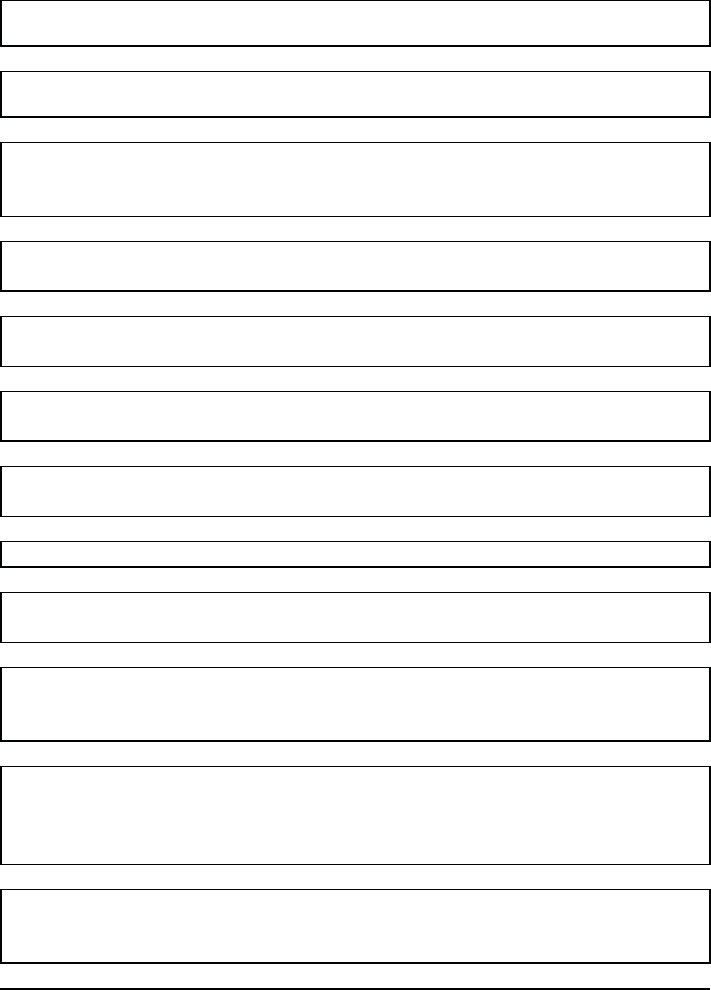
the operating instructions or as marked on the unit. If you are not sure of the type of
power supply to your home, consult your local dealer or power company.
WARNING: Do not open the housing on this unit, as this may expose you to dangerous
voltages and radiation.
WARNING: The unit should be connected to a power supply only of the type descry bed
in the operating instructions or as marked on the unit. If you are not sure of the type of
power supply to your home, consult your local dealer or local power company.
WARNING: Do not open the housing or touch any parts in the inner mechanism. Consult
your local dealer for technical service if the opening is required.
WARNING: The mains plug is used as the disconnect device, the disconnect device
shall remain readily operable.
WARNING: The battery of remote control should not be exposed excessive heat such as
sunshine, fire or the like.
WARNING: Maintenance personnel must use the appropriate tools and replacement
parts as specified by the manufacturer.
Note: Do not open the housing to avoid the unit direct exposure to radiation.
Unit Cleaning:
A
fter the unit power is turned off, you can clean the housing, panel and
remote control with a soft cloth lightly moistened with a mild detergent solution.
Attachments: Never add any attachments and/or equipment without the manufacturer
consent; as such additions may result in the risk of fire, electric shock or other personal
injury.
Locating: Slots and openings in the housing are provided for ventilation to protect it from
overheating. Do not block these openings or allow them to be blocked by placing the
STB on a bed, sofa or other similar surface, nor should it be placed over a radiator or
heat register.
Power Cord Protection: Place the power supply cord out of the way, where it will not be
walked on. Please take special attentions to cords at plugs, convenience receptacles and
the point where they exit from the unit.

Object and Liquid Entry: Never put objects of any kind into this STB through openings,
as they may touch dangerous voltage points or short-out parts that could result in a fire or
electric shock. Never spill any liquid on the STB.
Note: Moisture may be formed inside the unit in the following conditions:
When the unit is suddenly moved from a cold environment or an air-condition room to a
warm place.
Immediately after a heater has been turned on.
In a steamy or very humid room.
If the moisture forms inside the unit, it may not operate properly. To correct this problem,
turn on the power and wait about two hours for the moisture to evaporate.
Parts Replacement: When parts need to be replaced, user should make sure the
service technician use the replacement parts specified by the manufacturer or having the
same characteristics as the original part. Unauthorized replacement may put the unit in
the risk of fire, electric shock or other hazards.
Safety Check:
A
fter all the maintenances and repairs are done, user is required to
request the service technician to conduct the overall safety check to ensure the machine
is in the proper operating condition.

Contents
1
Contents
1. Remote Control & Panel Description....................................................................3
1.1 Front Panel Description ......................................................................................... 3
1.2 Rear Panel Description.......................................................................................... 4
1.3 Remote Control Description................................................................................... 5
2. Basic Operation........................................................................................................7
2.1 Switch on the STB ................................................................................................. 7
2.2 Standby ................................................................................................................. 8
2.3 MUTE .................................................................................................................... 8
2.4 TV/RADIO.............................................................................................................. 8
2.5 TXT........................................................................................................................ 8
2.6 INFO...................................................................................................................... 8
2.7 REW ◄◄ .............................................................................................................. 8
2.8 PLAY/PAUSE ►II.................................................................................................. 9
2.9 FFW ►►............................................................................................................... 9
2.10 BACK................................................................................................................... 9
2.11 STOP Ϯ............................................................................................................. 9
2.12 REC ϥ.............................................................................................................. 10
2.13 CH ϧ/ϰ........................................................................................................... 10
2.14 VOL ◄/►.......................................................................................................... 10
2.15 OK ..................................................................................................................... 10
2.16 Menu.................................................................................................................. 10
2.17 Exit..................................................................................................................... 10
2.18 Audio ................................................................................................................. 11
2.19 EPG................................................................................................................... 11
2.20 SUB ................................................................................................................... 12
2.21 Channel Numbers.............................................................................................. 12
2.22 ZOOM................................................................................................................ 12
2.23 FAV.................................................................................................................... 12
3. ATSC Installation....................................................................................................13
3.2 ATSC Channel Scan......................................................................................... 13
3.1.1 ATSC Auto Scan........................................................................................... 13
3.2 Channel............................................................................................................. 14
3.2.1 TV Channel List ................................................................................................ 14
3.2.2 Favorite ......................................................................................................... 14
3.2.3 Move ............................................................................................................. 15
3.1.4 Sort ............................................................................................................... 15
3.3 Radio Channel List............................................................................................ 17
3.4 Delete All........................................................................................................... 17
4. System Setup ........................................................................................................18
4.1 Language ...................................................................................................... 18
4.2 TV System..................................................................................................... 19
4.3 Display Setting............................................................................................... 19
4.4 Local Time Setting......................................................................................... 20
4.5 Time Setting .................................................................................................. 21
4.6 Parental Lock................................................................................................. 22
4.7 OSD Setting................................................................................................... 23
4.8 Favorite ......................................................................................................... 23
4.9 Other ............................................................................................................. 24

Contents
2
5. Tools.......................................................................................................................25
5.1 Information..................................................................................................... 25
5.2 Factory Default .............................................................................................. 25
5.3 S/W Upgrade by OTA.................................................................................... 26
6. Rec ........................................................................................................................ 27
6.1 PVR Storage Information............................................................................... 27
6.2 PVR Setting................................................................................................... 28
6.3 Upgrade by USB............................................................................................ 28
6.4 Media Management....................................................................................... 28
6.4.1 Media List...................................................................................................... 29
6.4.2 All.................................................................................................................. 30
6.4.3 Record Management..................................................................................... 30
6.5 Remove USB device safely ........................................................................... 31
7. Conditional Access ................................................................................................ 32
8. Troubleshooting ......................................................................................................33
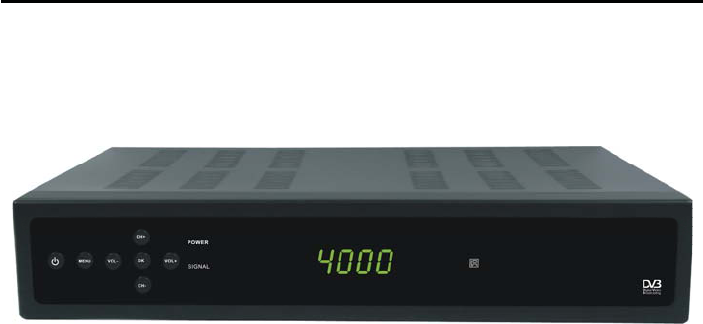
3
Menu Operations
1. Remote Control & Panel Description
1.1 Front Panel Description
1 Power To switch the STB between the working mode and the standby
mode.
2 MENU To enter into the main menu and exit all menus.
3 VOL+/- To change volume to move cursor, change numbers in the menu
or to change the choice.
4 CH+/- To change channels or for navigating and changing values in
menus.
5 OK To select an item in the menu and confirm it or pop up channel list
when no menu.
6 Display (4-Digit/7-Segment) Displays the received channel number while operating
and time while in standby mode.
7 Remote Sensor Detects the infrared signals from the remote control unit.
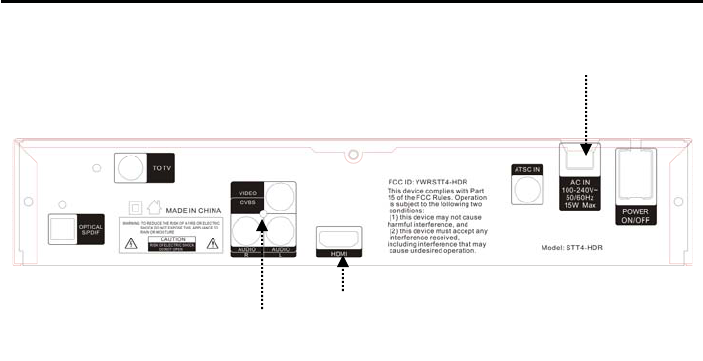
4
Menu Operations
HDMI
Output
Video / Audio
Output
AC IN
1.2 Rear Panel Description
S/PDIF: Coaxial output for digital audio (AC3)
TO TV: Modulator output for the connection to a TV set.
VIDEO: Composite video output for connecting to your TV video input jack.
AUDIO: HiFi outputs for stereo set.
HDMI: HDMI output for the connection to a TV set.
ATSC IN: Agate signal input
AC IN:
Mains input cable.
POWER ON/OFF: Allows to completely switch off the receiver.
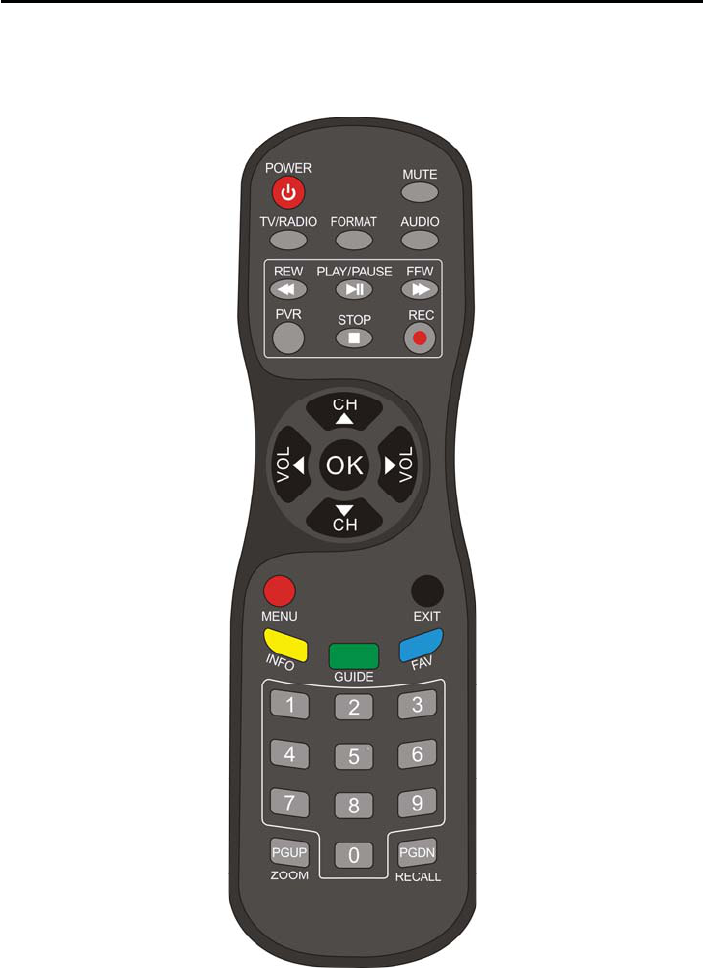
5
Menu Operations
1.3 Remote Control Description

6
Menu Operations
Power: The power key turns the STB on and off.
Mute: This key switches the sound on and off.
TV/RADIO: Selects TV or Radio channels.
TXT: Used to display the Teletext data.
INFO: Shows the information and parameters of current channel.
◄◄ REW: Back the recorded program fast.
►II PLAY/PAUSE: Will stop the recorded program and again will play the program continually.
Will start Timeshift.
►► FFW: Fast forward the recorded program.
■ STOP: Will stop the recording and want to stop play record and Timeshift.
● REC: Will start the recording.
BACK: Toggle between the actual and the last selected channel.
CH▲/▼: Used to move the highlight bar or change channel up / down.
VOL◄/►: Used to move the highlight bar or change volume up / down.
OK: The OK key is used to select a program, highlight line or parameter value. It
is also used to show the TV/RADIO channel list while watching TV or listening
to the RADIO.
Menu: Used to display the main menu.
Exit: Use this key return to the viewing mode from any menu function.
Audio: Open the Audio Mode window.
EPG: The EPG supplies information such as channel listings, program
descriptions, and starting/ending times for all programs.
SUB: Used to display the subtitle data.
Numeric (0-9): Numeric keys enable direct channel selection.
Zoom: Allows you to magnify a certain area on the images.
FAV: Change to last favorite channels or selects the favorite channels in the
channel list.

7
Menu Operations
2. Basic Operation
2.1 Switch on the STB
When the STB is first used it will display “Quick Setup” window. You can set Language, First Audio
and Second Audio and Country. Also you can search here your channels in “Cable search”. Please
press OK and you will see the window “Auto Scan”.
1. You have to set the parameters of “First Frequency”, therefore use the number buttons of the
RCU.
2. You have to set the parameters of “Second Frequency”, therefore use the number buttons of
the RCU.
3. You have to set the parameters of “Symbol Rate”, therefore use the number buttons of the
RCU.
4. Scan Mode: Press [◄/►] to switch this function “16QAM”, “32QAM”, “64QAM”, “128QAM”,
“256QAM”, “64QAMB” and “256QAMB”.
5. NIT Search: Press [◄/►] to switch this function “Yes” or “No”.
6. Moving the highlight to “Search” item and press [OK] key to start scanning.
? Frequently Asked Question
Q: The power of my STB is on and it is running in TV mode but the TV screen shows nothing:
A: Make sure the TV set has been set to the correct video input (not the TV channels). For
example, if you have connected the unit to the video1 input of the TV set then you need to select
the corresponding input of the TV. Mostly it is done with the AV button of the TVs remote control
unit.
Q: My STB is running in TV mode but the TV screen shows nothing except one ball and “No
Signal”.
A: The signal of current TV channel is too weak. You can try to change to other channels with a
stronger signal. If the problems still exist, please consult your local dealer or installer for
technical service.
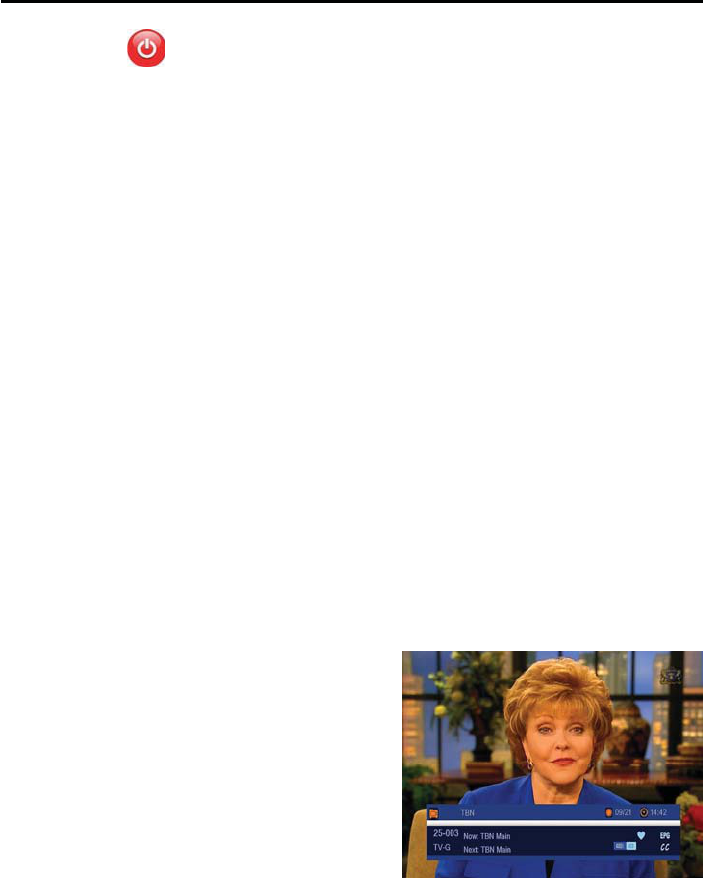
8
Menu Operations
2.2 Standby
1. Press power button to switch from TV/RADIO mode to standby mode
2. In standby mode press power button again to switch back to TV/ RADIO mode. The last active
channel will be showed.
3. To switch off the STB complete disconnect the power supply on the back side of the STB.
2.3 MUTE
1. Press the [Mute] button to mute the sound. An icon will be displayed on the screen to indicate
the sound has been muted.
2. Press the [Mute] button again to restore the sound.
2.4 TV/RADIO
In TV mode, press [TV/RADIO] to switch to Radio mode. In Radio mode press [TV/RADIO] again to
switch back to TV mode.
2.5 TXT
Press [TXT] to display the Teletext data.
2.6 INFO
Press the [INFO] button to open the information
screen. This window will show the channel number
being received, the channel ID, program description,
and the current date and time. Press the button twice
you will see the description from the current program,
and tree times will open an information screen, which
shows the parameters of current channel.
2.7 REW ◄◄
Press [◄◄] button for fast rewind recording when you are playing a recorded channel.
Selection: 2x, 4x, 8x speed.

9
Menu Operations
2.8 PLAY/PAUSE ►II
When you play a recorded program, press [►II] will stop the program, press [►II] again will play the
program continually. Also Timeshift is started by this key.
The Timeshift function allows you to interrupt a program in progress and continue viewing it at a
later time. The receiver records the program on the USB storage device. The current screen will be
paused, enabling you continue watching from this point onwards. This menu item must be enabled
for you to use this function.
Press the [►II] button once in normal mode and you will see a window with the question: “Start
timeshift?”. Press [►II] again to start or [EXIT] to go back.
When you want to continue viewing the program, press the [►II] button. You will now see the
program starting from the point at which you started timeshift.
2.9 FFW ►►
When you play a recorded channel press [►►] for fast forward the recording.
Selection: 2x, 4x, 8x speed.
2.10 BACK
Press the [BACK] button to toggle between the current channel and the selected channel.
2.11 STOP
■
When you play a recorded program, press [■] button
will stop the recorded channel playing and go back to
the Record Management menu. When you are
recording a program, press [■] button you will be asked:
“Do you want to stop record?”.
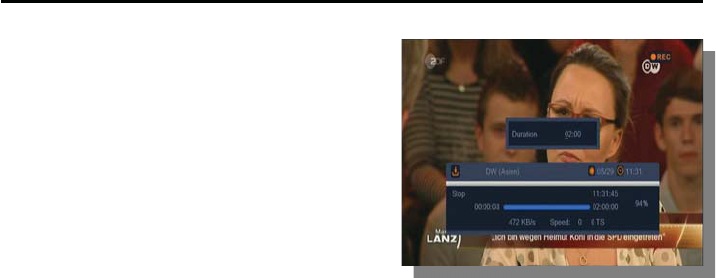
10
Menu Operations
2.12 REC
●
In TV mode, press [●] button you will be asked to start
record.
2.13 CH ▲/▼
Press the [CH▲/▼] buttons to change the channel.
2.14 VOL ◄/►
Press the [VOL◄►] buttons to adjust the volume. In the menu move the highlight bar. And if you
play back a recording and you are in the REW/PLAY/FFW menu and press [VOL◄/►] you will jump
5 min. back or forward in your recording. This is set as default in the “Media Management” point 3.5
USB.
2.15 OK
1. In TV mode press [OK] button to open the Channel List window.
2. Press the red button to exchange screen.
3. Press [FAV] button to open FAV list. After selecting a Favorite Group the channel list will be
reduced to the channels of this group.
4. Press blue button to open the Find window. You can use this feature to find channel by their
names.
5. Press [OK] to change and display the marked channel.
2.16 Menu
Press the [Menu] button to enter or exit the current menu.
2.17 Exit
Press the [Exit] button to exit the current menu.
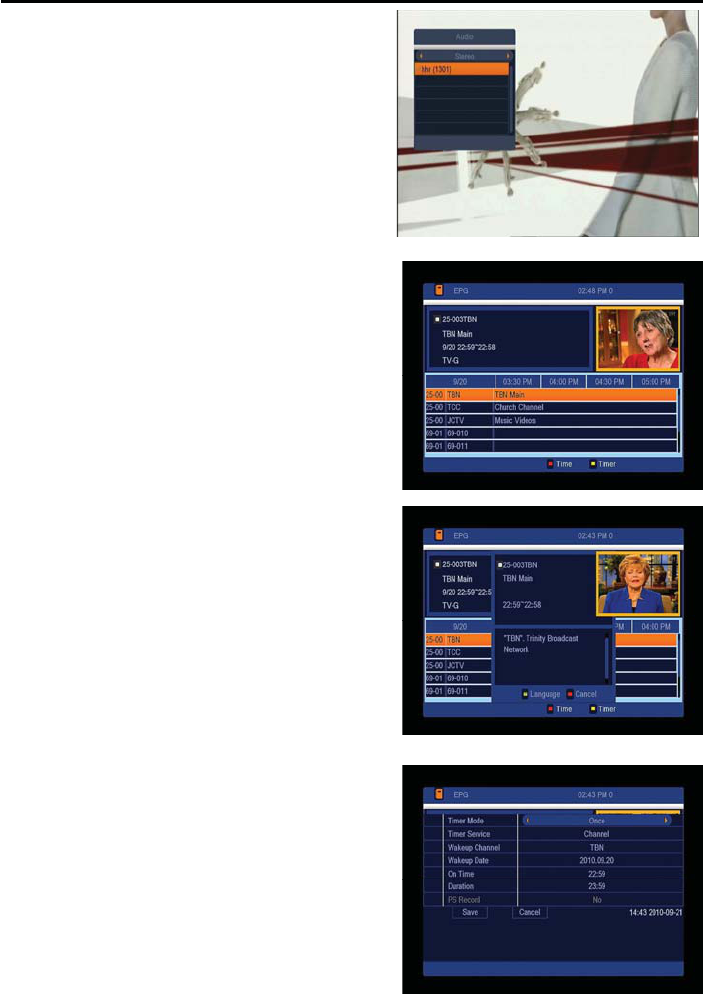
11
Menu Operations
2.18 Audio
1. In TV mode, press the [Audio] button to open
the Audio Track window.
2. Select the item you want to adjust with
[CH▲/▼] and change the value with
[VOL◄/►].
2.19 EPG
The STB supports Electronic Program Guides (EPG)
to give you information about the actual programs of
certain channels like event name, subtitle, description,
start and finish time. This feature is depending on the
service of the channel provider.
Press [EPG] to open the EPG window.
1. You can move the highlighted channel with
[CH▲/▼] and preview the highlighted program
in the preview window with [VOL◄/►] and
display the event’s detailed description.
2. Press the [INFO] button in the EPG menu to
display the detailed information of the actual
event in the selected channel.
3. Press the red button in the EPG menu to
program a timer with the actual events data.
4. Press the [Green / Yellow] to select date.
5. To close the EPG menu press [EXIT / MENU].
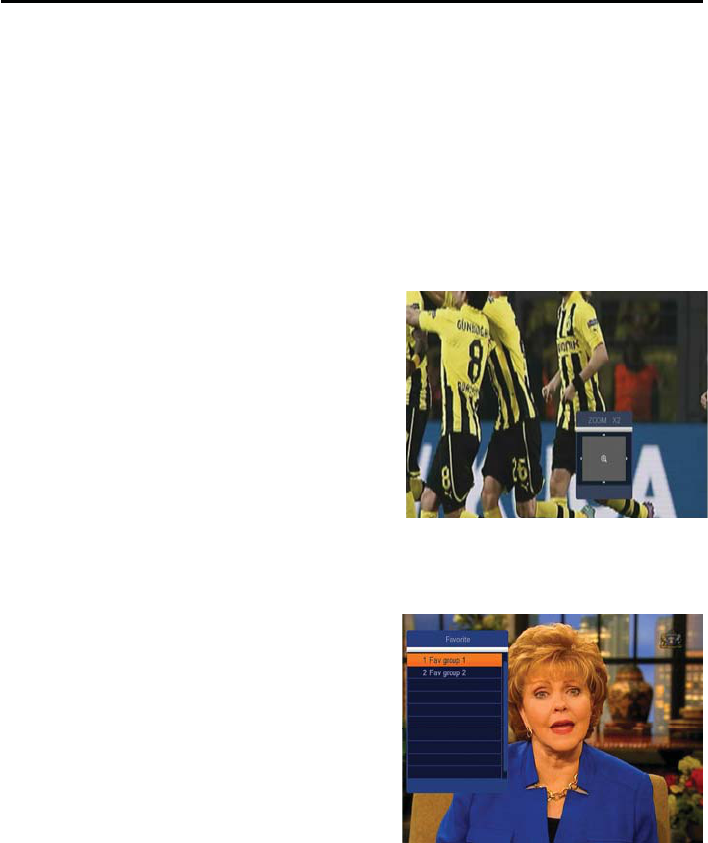
12
Menu Operations
2.20 SUB
In “Subtitle Display” menu press [◄/►] to select “On” or “Off”. Press [◄/►] to select languages. If
the current channel has subtitle information, it will be displayed if this function is “On”. If this function
is “Off” subtitles won’t be displayed.
2.21 Channel Numbers
In TV mode you can enter the channel number directly with your remote control unit and confirm the
number with the [OK] button, to change to the desired channel.
2.22 ZOOM
1. The [Zoom] key allows you to magnify a certain
area on the images and the current screen will
show it.
2. Press [Zoom] key again, the image will enlarge
rotate as x1, x2, x4, x6, x8, x12, x16.
3. In “x2 ~ x16” image, using [▲/▼ / ◄/►] keys to
move the image centre area you want to see.
4. In zoom mode, press [Exit] to close the window.
2.23 FAV
1. In TV mode press the [FAV] button to display the
Favorite Group window on the screen as the
picture beside shows.
2. In the Favorite Group window you can select the
desired favorite channel with [▲/▼] and confirm
it with [OK] to switch to it. With [◄/►]. You can
select different Favorite Groups.
3. Press [Exit] to close the Favorite Group window.
? Frequently Asked Question
Q: Why the screen displays “No favorite program!” after pressing the [Favorite] button?
A: No channels have been assigned to a Favorite Group yet. You can do this in the channel
menu.
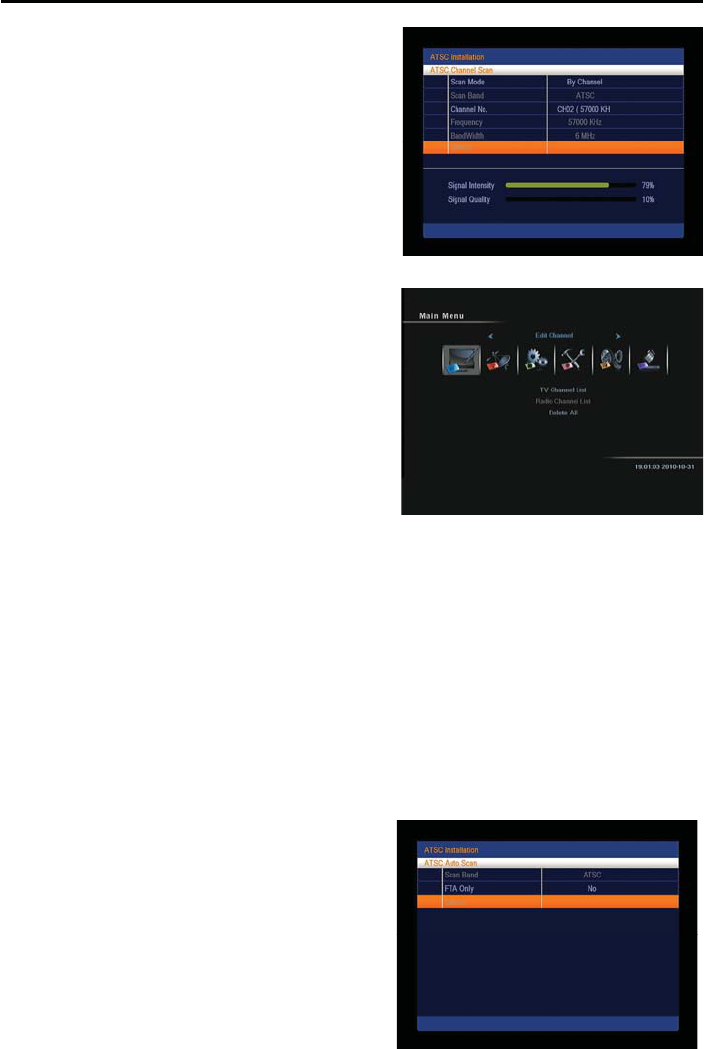
13
Menu Operations
3. ATSC Installation
In “Antenna Connection” menu;
3.1 ATSC Channel Scan
In “ATSC Channel Scan Search” menu;
1. In the “Satellite” item press [OK] to open the “satellite list” to select directly
with [CH▲/▼], press [OK] to confirm it.
2. FTA Only: Press [Vol◄/►] to select to scan only free channels or even
scrambled channels. If you select “Yes” it will scan free channels only.
3. Scan Channel: Press [Vol◄/►] to select to scan TV + radio, or just TV or
just radio.
4. Network Search: Press [Vol◄/►] to select to scan Yes or No.
5. Scan Mode: You can select “Auto Scan” or “Preset Scan” to blind scan
preset transponders or network transponders of the selected satellite.
6. Search: Press [OK] to start scanning. In the lower part of the window the
progress of scanning and the found channels are displayed.
3.1.1 ATSC Auto Scan
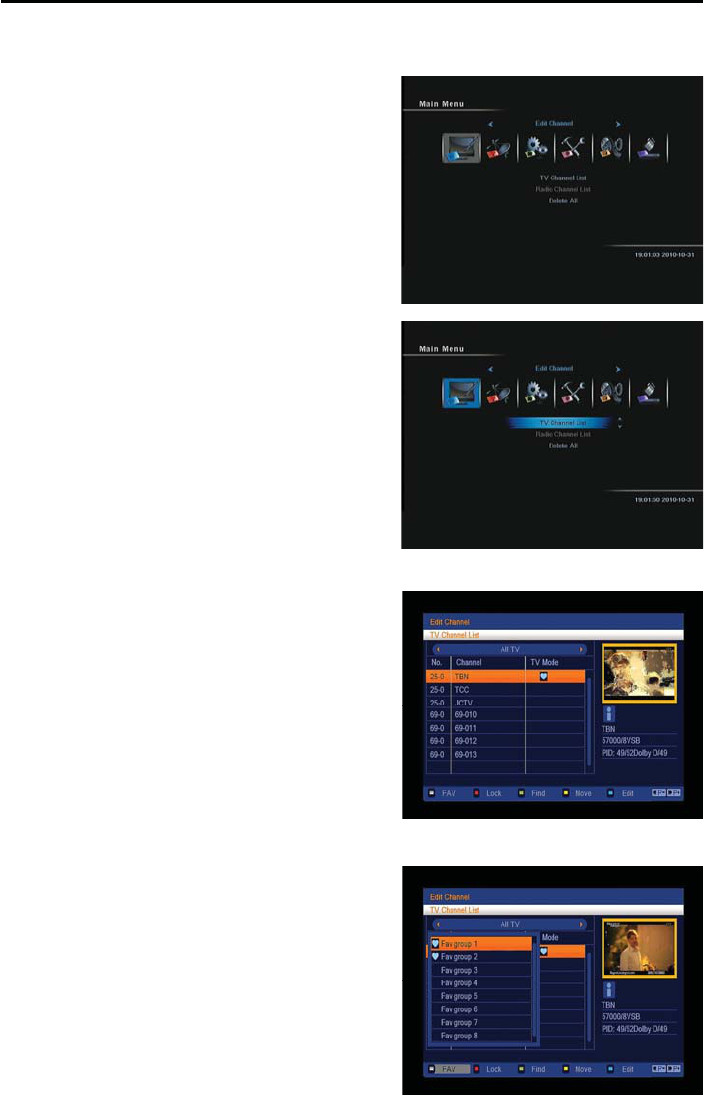
14
Menu Operations
3.2 Channel
Press [Menu] in the TV/RADIO to enter the main
menu.
1. Press [CHƷ/ͩ] to select the channel item.
2. Press [OK] to enter the selected item.
Press [CHƷ/ͩ] to select the wanted menu item
among TV Channel List, Radio Channel List, Channel
setup, Favorite group list name and Delete All.
Press [OK] to enter the selected item.
3.2.1 TV Channel List
If you enter the channel list menu a window like the
one beside will open.
1. You can move the highlighted channel with [CH
Ʒ/ͩ] and press [OK] to preview the highlighted
program in the preview window.
2. Press [VOL◄/►] to switch between the program
groups.
3. Press [Menu] or [Exit] buttons to enter TV playing
mode.
4. The color buttons offer further functions to manage the channel list.
3.2.2 Favorite
1. Press [FAV] to open the favorite window.
2. You can select between 32 favorite groups with
[CH▲/▼]. Press [OK] to assign the channel
which you selected to the marked favorite group.
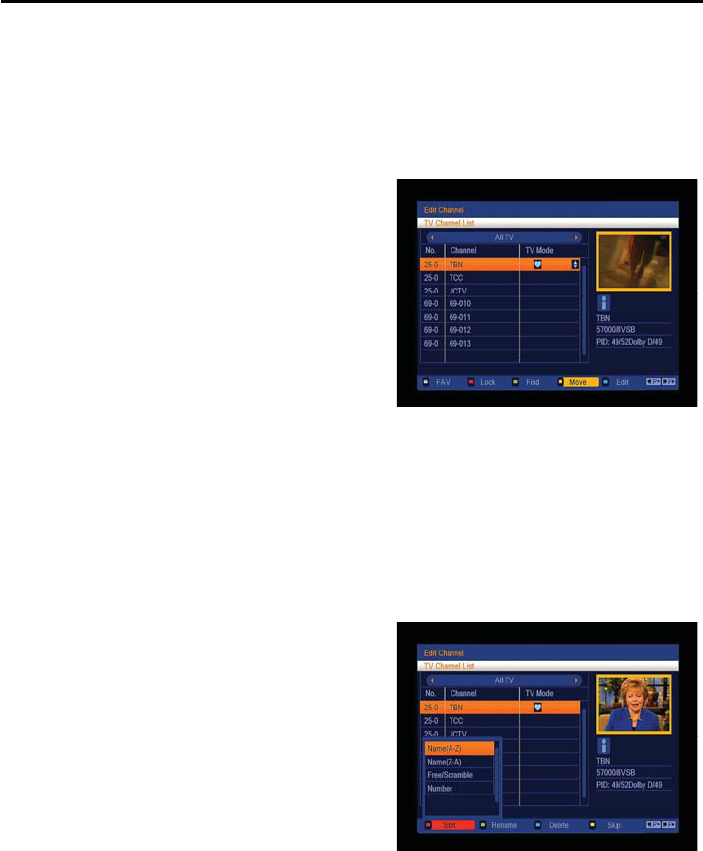
15
Menu Operations
3. The channels of favorite groups are indicated with a favorite icon behind the name.
4. Press [OK] again to remove the channel from the marked favorite group.
5. Press [Menu] button you will be asked “Are you sure to save?” current. Select “Yes” to save the
marked favorite group. Select “No” to cancel the operation and return to the TV channel list.
3.2.3 Move
Pressing the red button in the TV channel list will
open another window where you can choose
between move the actual channel and swap the
actual channel to the desired position, press [OK] to
confirm it.
a) Move
1. Press red button to show a moving icon behind
the channel name.
2. Move the channel to the desired position with
[CH▲/▼]. Press [OK] to confirm the position.
b) Swap
1. Press green button to show a moving icon behind the channel name.
2. Move the channel to the desired position with [CH▲/▼]. Press [OK], then the selected channel
will immediately exchange positions with the channel currently occupying this position.
3.1.4 Sort
Press green to open the sort window. Press [CH▲/▼]
to select and [OK] to confirm your choice.
The ways of sorting are:
♦ Name (A-Z): Sorting in Alphabetical order,
ignoring “$” symbol.
♦ Name (Z-A): Sorting in Alphabetical order,
ignoring “$” symbol.
♦ FTA: Sort channel by free and scrambled
sequence. Free channels will be listed first and
scrambled channels behind in the channel list.
♦ Lock: Unlocked channels are listed first end locked channels at the end.
♦ Default: Sort channel factory default.
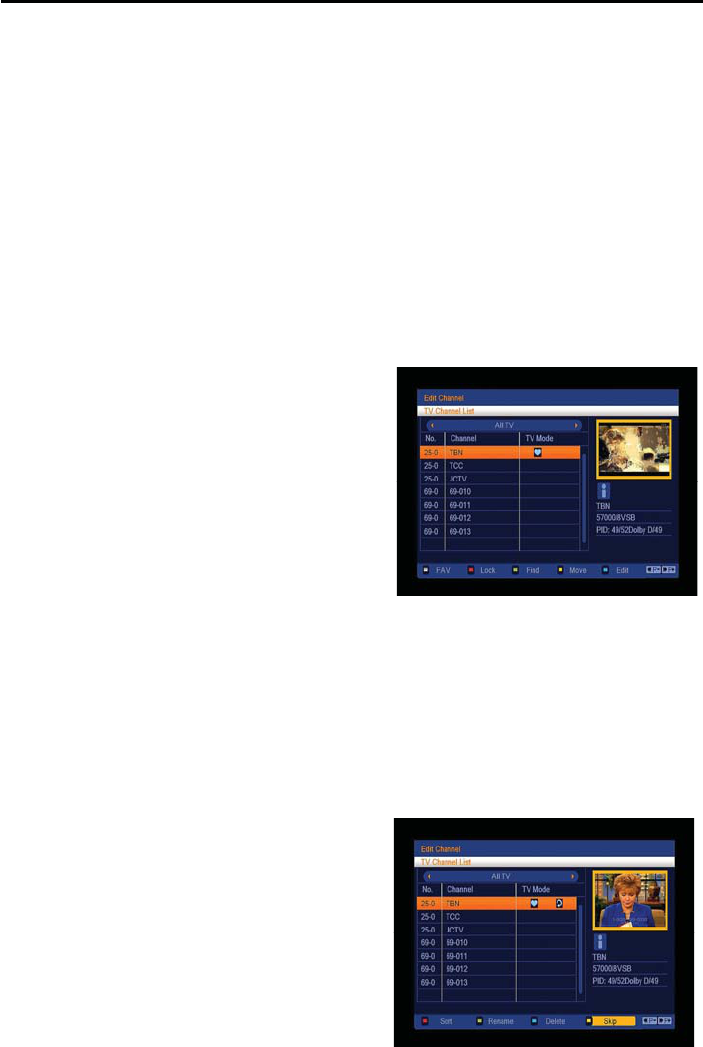
16
Menu Operations
3.2.5 Delete
In channel edit menu press red button will open another window where you can choose between
delete one channel or delete all channels.
♦Del One
Press red button to mark a channel for deleting. Marked channel will be deleted after you
confirm to save the changes when you leave this menu.
♦Del All
a) Press green button to show a deleting icon behind all channel name.
b) Press [MENU] button you will be asked “Are you sure to save?”. Select “OK” to delete all
channels. Select “Cancel” to cancel the operation.
3.2.6 Edit
Pressing the blue button in the TV channel list edit
menu will open another window where you can
choose between edit the actual channel and create a
new channel.
♦Edit
Press red button to edit the channel.
1. Selecting the name item with [OK] will
display a button pad to show you how to
edit the channel name.
2. On the “Video PID”, “Audio PID” and “PCR PID” items you can input numbers to modify
the item’s value.
3. After modification select “Save” and press [OK] button to save the modified values and
exit “Edit” mode. Or select “Exit” and press [OK] to leave edit mode without saving the
modifications.
3.2.7 Skip
In channel edit menu, press green button to place a
skip icon behind the name of the highlighted channel.
Marked channels will be skipped when you change
channels in TV mode after you confirm to save the
changes when you leave this menu.
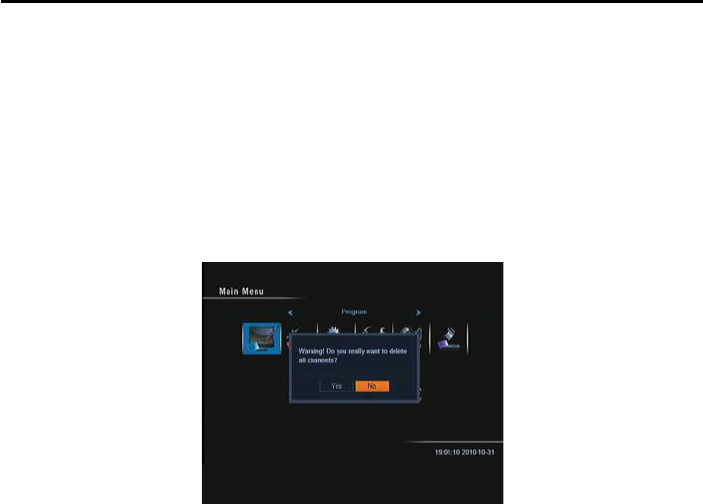
17
Menu Operations
3.3 Radio Channel List
Basically the operation of “Radio Channel List” is same as “TV Channel List”, except that in the
small channel window the radio Logo will be displayed.
3.4 Delete All
To delete all channels:
1. Enter the password. The default password is “0000”.
2. After entering the password correct a safety question will show up where
you have to confirm first
3. Select “OK” to delete all channels or “Cancel” to cancel the operation and
confirm with [OK].
4. In step 1 and step 2, pressing [Menu] will exit the function directly without
saving.
?
Frequently Asked Question
Q: IF I incautiously delete all channels, what should I do?
A: there are two ways to restore:
To research all channels in the “Installation” menu.
Use “Factory Default” function to restore all channels in the “Tools” menu.
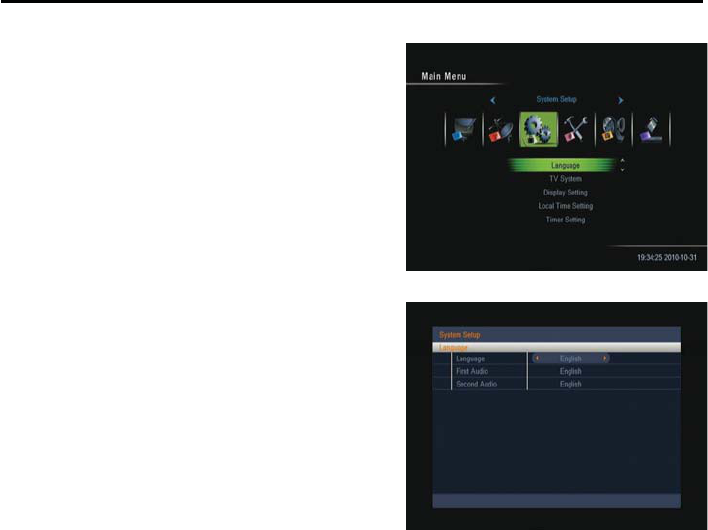
18
Menu Operations
4. System Setup
When you open the “System Setup” menu a window
like the one beside will be opened.
In “System Setup” menu:
1. Press [CH▲/▼] to select menu items among
Language, TV System, Time & Timer setting,
OSD Setting, Parental Lock, Power setting,
TCP/IP Setting and MAC Setting.
2. Press [OK] to open the selected item.
4.1 Language
After selecting the “Language” menu you will see a
window as shown here:
1. Menu Language: Press [VOL◄/►] to select from
the many available menu language include:
English, German, French, Spanish, Italian,
Portuguese, Turkish, Polish, Russian, Danish,
Greek, Hungarian, Dutch, Arabic, Farsi,
Kiswahili, Swedish, Bulgarian, and Slovakian.
2. First Audio: Some channels offer more than one audio language. This function allows you to
set the preferred audio language for those channels. If a channel offers the same audio
language as the “First Audio” you set the system will play this audio language as default. If the
channel does not offer this audio language then the system will compare the offered
languages with the second audio language. The selections of audio language include: English,
German, French, Spanish, Italian, Portuguese, Turkish, Polish, Russian, Danish, Greek,
Hungarian, Dutch, Arabic, Farsi Kiswahili, Swedish, Bulgarian, and Slovakian.
3. Second Audio: If the channel has no audio language that corresponds with “First Audio” but
with “Second Audio” the system will play the second audio language as default. If no audio
language corresponds with the “Second Audio” then the default language of the current
channel will be played instead. The selections of audio language include: English, German,
French, Spanish, Italian, Portuguese, Turkish, Polish, Russian, Danish, Greek, Hungarian,
Dutch, Arabic, Farsi Kiswahili, Swedish, Bulgarian, and Slovakian.
4. Subtitle Language: In “OSD Setting” menu, use [VOL◄/►] to select “On” or “Off”. If the
current channel has subtitle information, it will be displayed if this function is “On”. If this
function is “Off” subtitles won’t be displayed. The selections of subtitle language include:
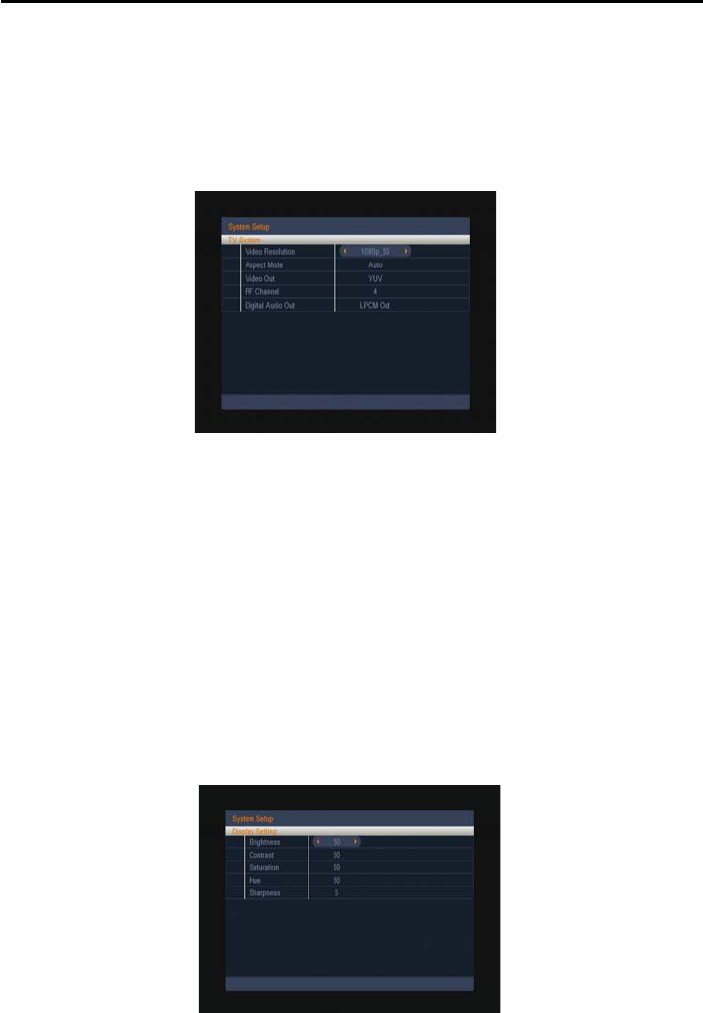
19
Menu Operations
English, German, French, Italian, Spanish, Portuguese, Russian, Turkish, Polish, Arabic and
Farsi.
5. Press [Menu/Exit] to return back from “Language” menu.
4.2 TV System
When you enter the “TV System” menu you will see the screen like below:
1. In Display Mode you can switch between Auto, PAL, PAL-M, PAL-N and NTSC. In HD Mode,
you can select from Auto / 720P_60 / 1080I_30. Press [VOL◄/►] to switch to the desired
mode.
2. Aspect Mode is used to switch the screen aspect ratio mode. You can select between Auto /
4:3 PS / 4:3 LB / 16:9 using the [VOL◄/►].
3. Video output is used for switching the screen aspect ratio mode. Now we provide below
options: HD / SD. You can press [VOL◄/►] key to select.
4. Press [Menu/Exit] to return to the previous menu.
4.3 Display Setting
In “Display Setting” menu;
1. Video Resolution:
Press [OK] to select directly
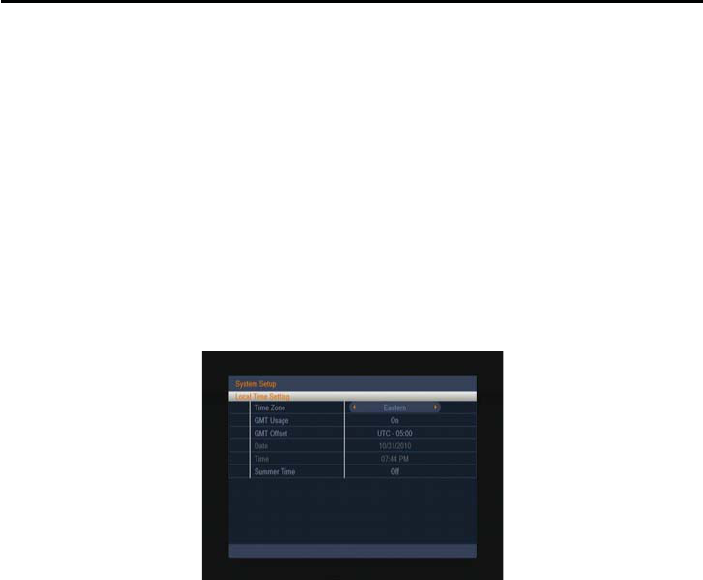
20
Menu Operations
with [CH▲/▼] to switch between 0~100.
2. Contrast: Press [OK] to select directly with [CH▲/▼] to switch between
0~100.
3. Saturation: Press [OK] to select directly with [CH▲/▼] to switch between
0~100.
4. Hue: Press [OK] to select directly with [CH▲/▼] to switch between 0~100.
5. Sharpness: Press [OK] to select directly with [CH▲/▼] to switch between
0~10.
6. Press [Menu/Exit] to return to the previous menu.
4.4 Local Time Setting
In “Local Time Setting” menu;
1. Region: Press [OK] to select directly with [CH▲/▼] to switch between UAE,
Algeria, Bahrain, Djibouti, Egypt, Iraq, Iran Jordan, Kuwait, Libya,
Mauritania, Morocco, Oman, Palestine, Qatar, Saudi, Somalia, Sudan,
Syria, Tunisia, Lebanon, Yemen.
2. GMT Usage: This item is used to set the time by using the time signal from
the satellite. Press [Vol◄/►] to change the setting.
3. The “GMT Offset” item is only available when “GMT Usage” is set to “On”.
Press [Vol◄/►] to set the “GMT Offset” value. With every time you press
the button the time offset will be increased /decreased by half an hour.
4. Summer Time: Press [Vol◄/►] to switch this function “On” or “Off”.
5. “Date” and “Time” items are only available when the “GMT Usage” is set to
“Off”. Press [Vol◄/►] to select one item and use number buttons to input
time and date directly.
6. NOTE: If the current channel provides the correct time information, you will
see the current time after you entered “Local Time Setting” menu. If the
channel doesn’t provide time information, you have to input the date and
time information manually. The most channels support the time signal.
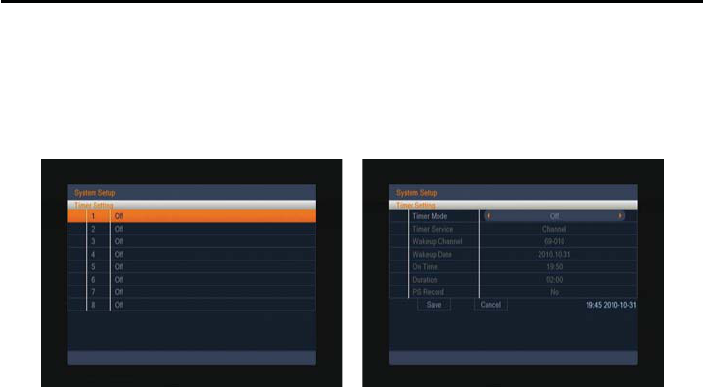
21
Menu Operations
7. Press [Exit] to leave the “Local Time Setting” menu.
4.5 Time Setting
In “Time Setting” menu;
You can press [CH▲/▼] to switch the timer number. There are totally 8 timers.
1. Timer Mode: Select how often the timer is running: Once, Daily, Weekly,
Monthly and Yearly, or switch the timer to off.
2. Timer Service: Select between TV Channel, Radio Channel and Message.
3. Wakeup Channel: Press [OK] to enter the channel list, and select the
channel you want to see with [CH▲/▼], press [OK] to confirm it.
4. Wakeup Date: Use number buttons to input your wakeup date.
5. On Time: Use number buttons to input your wakeup time. If date and time
are reached then no matter if the system is in standby mode or in playing
mode, it will automatically switch to the channel you set and start to play.
6. Duration: Here you can set the time you want to see or play this channel.
When the time is reached, whenever the system is in standby mode or
playing a channel, the system will automatically switch to the channel you
select and play the channel within the duration time you set. The minimum
duration unit is one minute. After the duration time, the system will
automatically switch to Standby mode.
7. PS Record: Press [Vol◄/►] to switch this function “No” or “Yes”.
8. Press [Save] to confirm it. Press [Cancel] to leave the “Time Setting” menu.
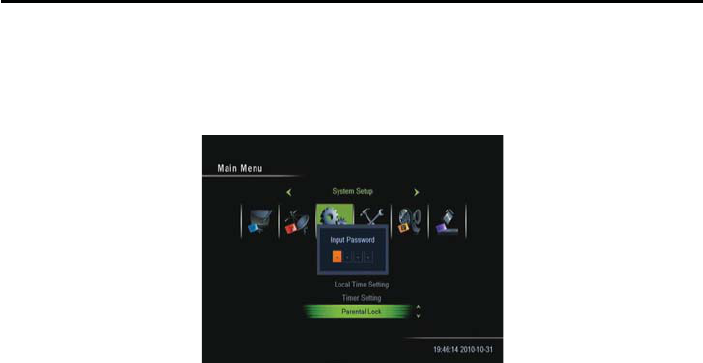
22
Menu Operations
4.6 Parental Lock
In “Parental Lock” menu;
You can set a password for anyone who wishes to operate the “Installation”
menu. You can also set the password to lock channels. Below you find how to
set and change the password.
1. On “Parental Lock” press [OK] to open a dialogue box and input the
password. After you entered the correct password, you will see a screen
like beside:
2. Menu Lock: If Menu Lock is set to “Yes” then you need to enter the
password every time you want to open the menu. If set to “No” then you
can open the menu without entering the password first.
3. Channel Lock: If set to “Yes” then you need to enter the password before
you can see those channels which have been marked as locked channels
in the channel menu. If set to “No” then even those channels can be
selected without entering the password first.
4. New Password: Here you can change the existing password. You should
do this after you set up the receiver the first time and every time when you
think that your password is known by unauthorized persons. To change the
password enter the new password in the “New Password” item and repeat
the same one in the “Confirm Password” item. If the passwords are not
identically then you will see a warning message. If you entered the same
new password in both fields then you will see the message “Saving Data,
Please Wait…”. From now on you need to use the new password to open
locked menus or locked channels.
NOTE: The default password is 0000.
5. Press [Exit] to leave the “Parental Lock” menu.
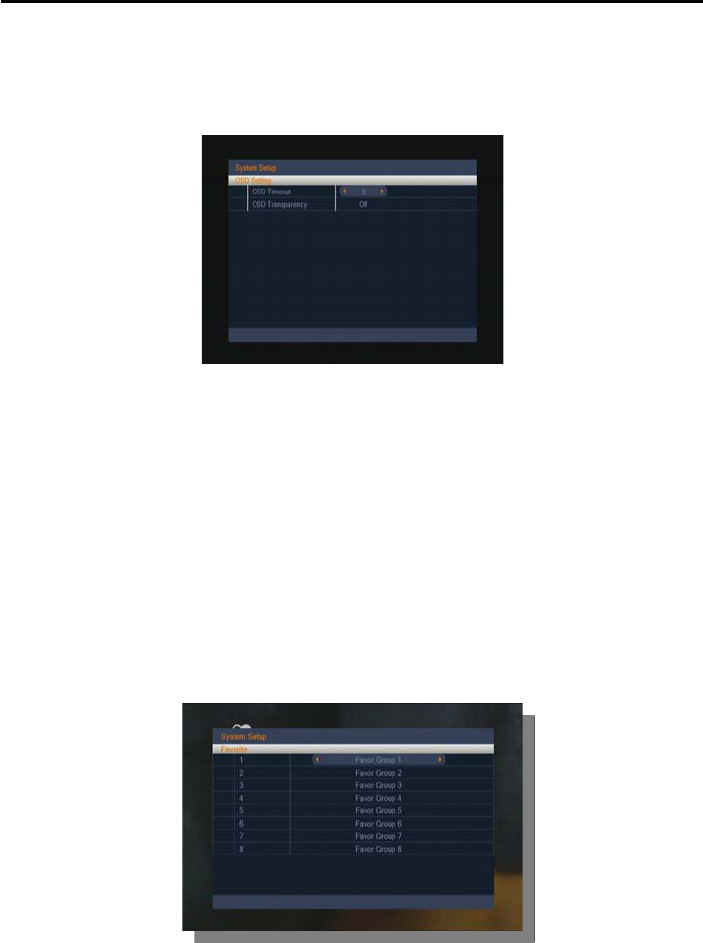
23
Menu Operations
4.7 OSD Setting
In “OSD Setting” menu;
1. OSD Timeout: This setting determines the duration the info window is
displayed on the screen when you change channels. Press [Vol◄/►] to set
the time between 1 to 10 seconds.
2. OSD Transparency: With this parameter you can set the transparency of
the menus. Press [Vol◄/►] select the value between 10%, 20%, 30%,
40% and “Off”(means no transparency function).
3. Press [Exit] button to leave the “OSD Setting” menu.
4.8 Favorite
In “Favorite” menu;
When you enter “Favorite” menu with 8 favorite group will be
displayed, press [OK] on the RCU to rename favorite group. Use [CH▲/▼] /
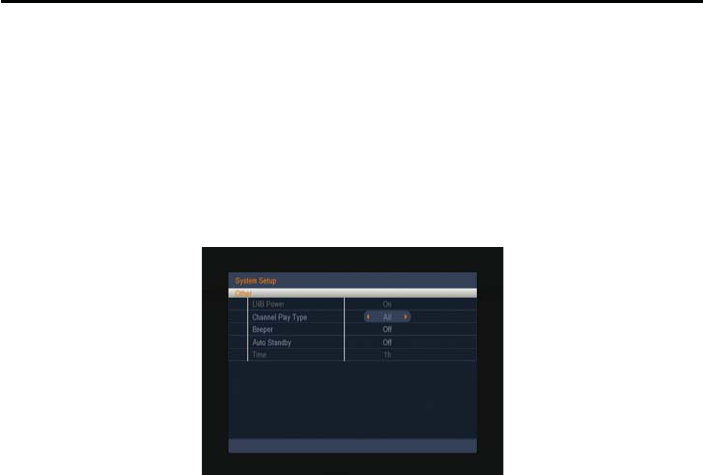
24
Menu Operations
[Vol◄/►] to select character, press [OK] to confirm it.
After modification select “OK” of button bar and press [OK] on the RCU to
rename the favorite group name and leave the edit mode. Press [Exit] on the
RCU to exit the edit mode without saving the favorite group name.
4.9 Other
In “Other” menu;
1. LNB Power: If your receiver is connected to the LNB directly then you need
to set the LNB Power to “On”. If your receiver is connected to a multi switch
(SMATV signal distribution system) then it may be that you don’t need to
provide the power to the LNB. But since this is depending on the kind of
installed distribution system we recommend you to contact your installer or
to refer to the user manual of this system to get the correct information.
You also just can change this setting and check if you still can receive the
channels. If the LNB Power is off and you still can see all channels then we
recommend this setting.
2. Channel Play Type: Press [Vol◄/►] to switch this function All, Free and
Scambled.
3. Beeper: Press [Vol◄/►] to switch this function On or Off
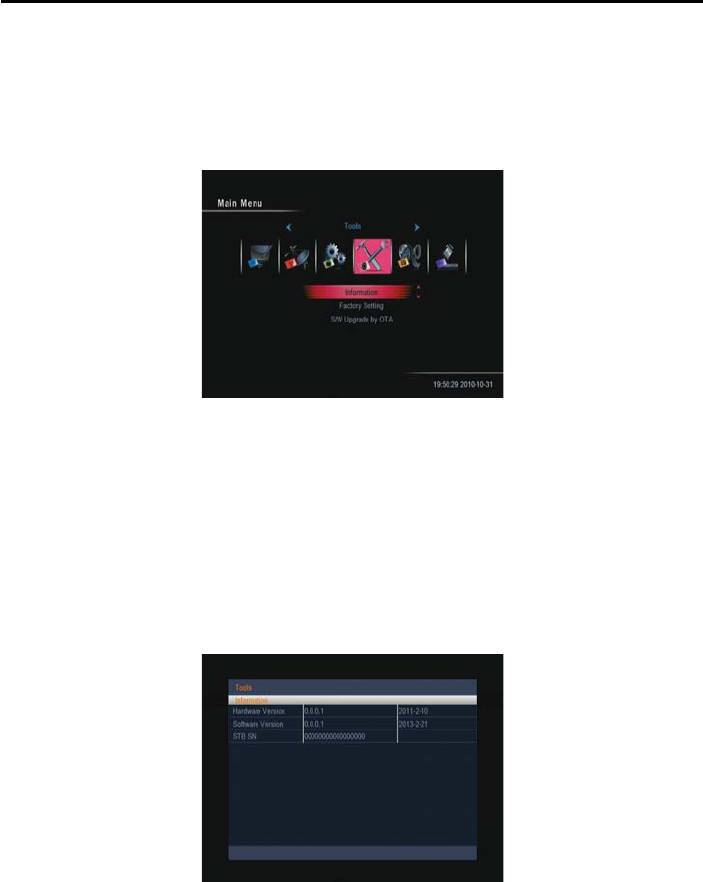
25
Menu Operations
5. Tools
After Tools the Settings menu you can see the window like.
In “Tools” menu;
Press [CH▲/▼] to select menu items among Information, Factory Setting, S/W
Upgrade by OTA.
5.1 Information
When you select the “Information” menu you will see a screen like beside.
On the right of the screen displays data about the current system.
5.2 Factory Default
When you press [OK] on the “Factory Default” item:
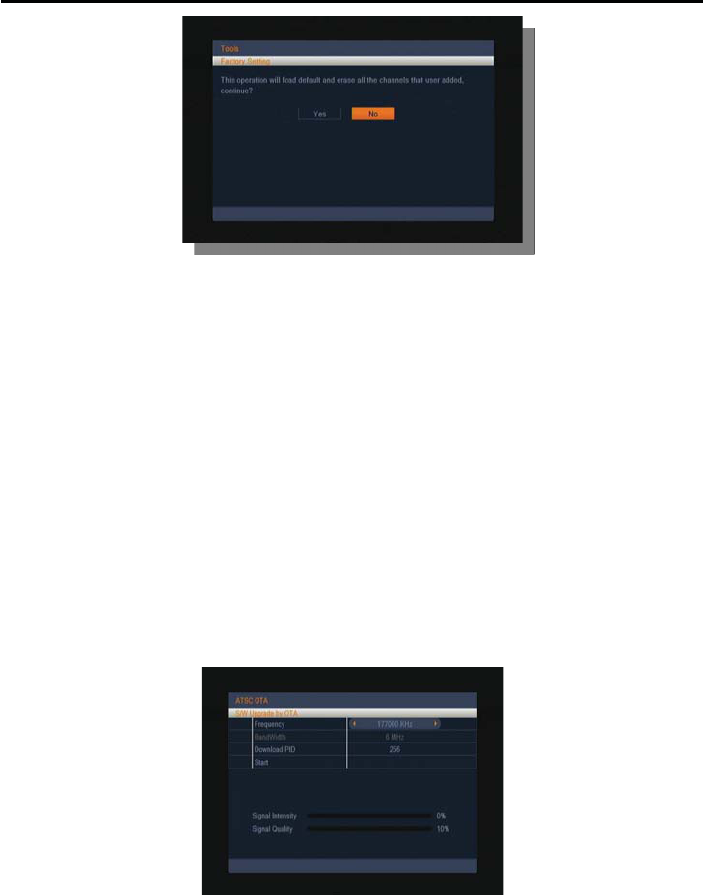
26
Menu Operations
A dialogue box will occur where you need to enter the password.
After you input the correct password a warning message will be displayed like
the one beside.
If you select “Yes” then all changes you made will be reset to default values.
Make sure you really want to do this!
Press [Exit] in both steps will close the window without resetting the receiver.
NOTE: The default password is 0000.
5.3 S/W Upgrade by OTA
This function can upgrade the software of your receiver through data sent by a
satellite. This option is used by Operator to send you the updated S/W through
satellite for your STB.
1. Select the satellite and TP or input the TP value and download PID.
2. Then mark “Start” and press [Enter] to begin the download of the upgrade.
This may need up to 60 minutes. Therefore we suggest using of this
function only if you don’t intent to watch TV during this time.
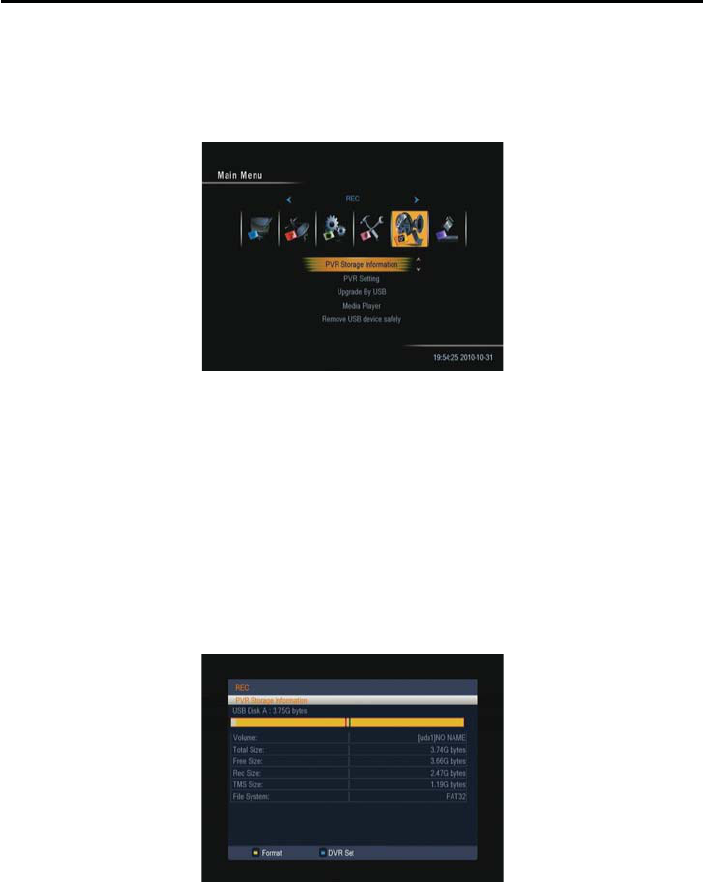
27
Menu Operations
6. Rec
In “Rec” menu;
Press [CH▲/▼] to select menu items among PVR Storage Information, PVR
Setting, Recorded Stream Manager, Remove USB device safely.
6.1 PVR Storage Information
Press [Vol◄/►] to select the wanted item partition.
When you select the “PVR Storage Information” menu you will see a screen like
beside. The screen displays data about the current HDD.
Press [Yellow] button, If you want to delete the hard disk totally, you can do it
with the [OK] Button Format and the hard disk will be completely erased.
Caution: This process will delete also saves you have made with Backup tools.
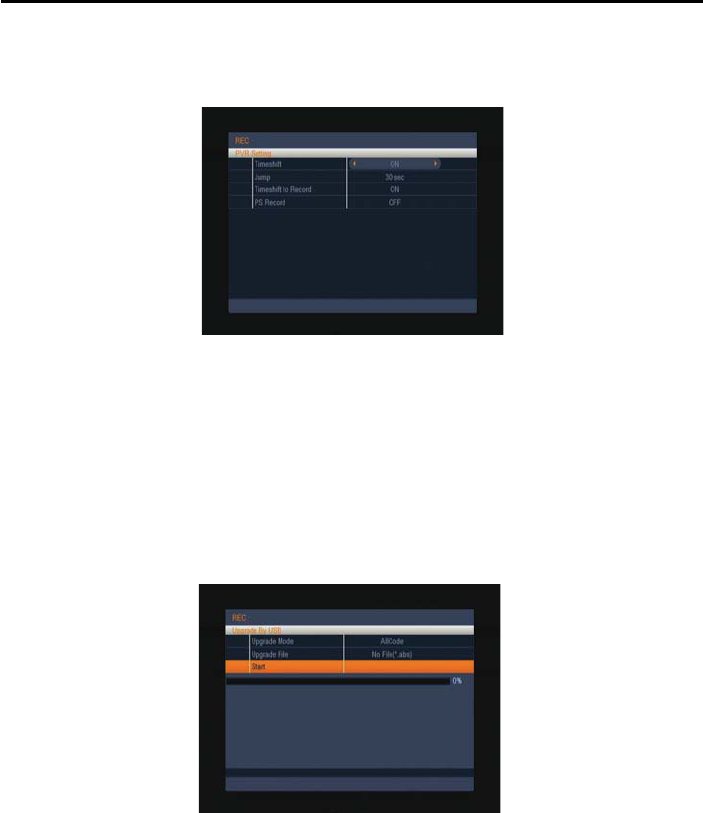
28
Menu Operations
6.2 PVR Setting
In “PVR Setting” menu;
Time shift: Press [Vol◄/►] to switch between ON or OFF.
Jump Step Value: Press [Vol◄/►] to switch between “1 mins / 5 Mins / 10 Mins /
30 Mins / 30 sec”.
6.3 Upgrade by USB
This function can upgrade the software of your receiver through data sent by
usb.
6.4 Media Management
Insert a readable USB storage device into the USB port on the receiver.
Important notes for the use of external hard drives and USB Stick's
Your receiver has a USB 2.0 interface to plug any external storage media for data transfer such as
an external hard drive or USB stick. This interface has a standard power output of 500mA. Please
note that you will only connect external hard drives with a separate power supply. For hard drives
without a separate power supply your receiver can not deliver a possible high inrush via USB to the
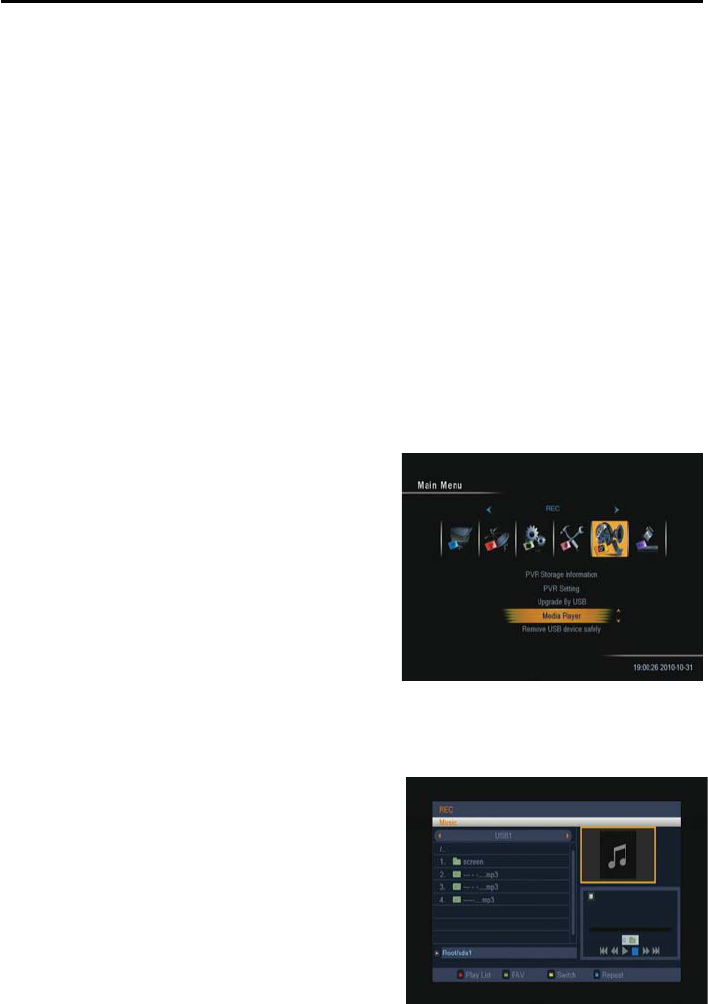
29
Menu Operations
hard drive.
If you want to transfer data (film / photo / music, etc.) with a USB stick start, please note when
buying that you buy a USB flash drive with a high read transfer rate and high write transfer rate.
These values should be 15-20 MB / sec. With these values, e.g. TV recording without the
interference e.g. judder of the image possible.
Please note that we will assume no liability for the specifications of the manufacturer of the USB
sticks and the external hard drive.
In storage capacity, please note details of the respective manufacturers. Please note the following
guidelines:
On a 2GB USB stick you can save about 35 hours of music, or about 500 songs or 2400 photos, at 3
Megapixels / or 1 hour movies in MPEG-2 format / and 1 hour and 30 minute films in MPEG-4
format.
Please note that these targets dependent to data size which should be saved. Broadcast TV
programs can differ significantly from the amount of data. This depends on the quality of each
broadcast TV station.
When you enter to “Media Management” menu, you
will see a screen like beside:
In “Media Management” menu:
1. Press [CH▲/▼] to select the Media List, Media
Control and Disk Information.
2. Press [OK] to enter the selected item.
6.4.1 Media List
Press [CH▲/▼] to select the desired item partition.
Press red button to open the “Rename” window like
showed beside. Press [CH▲/▼] / [VOL◄/►] to select
the leading character of the channel name and press
[OK] to confirm it.
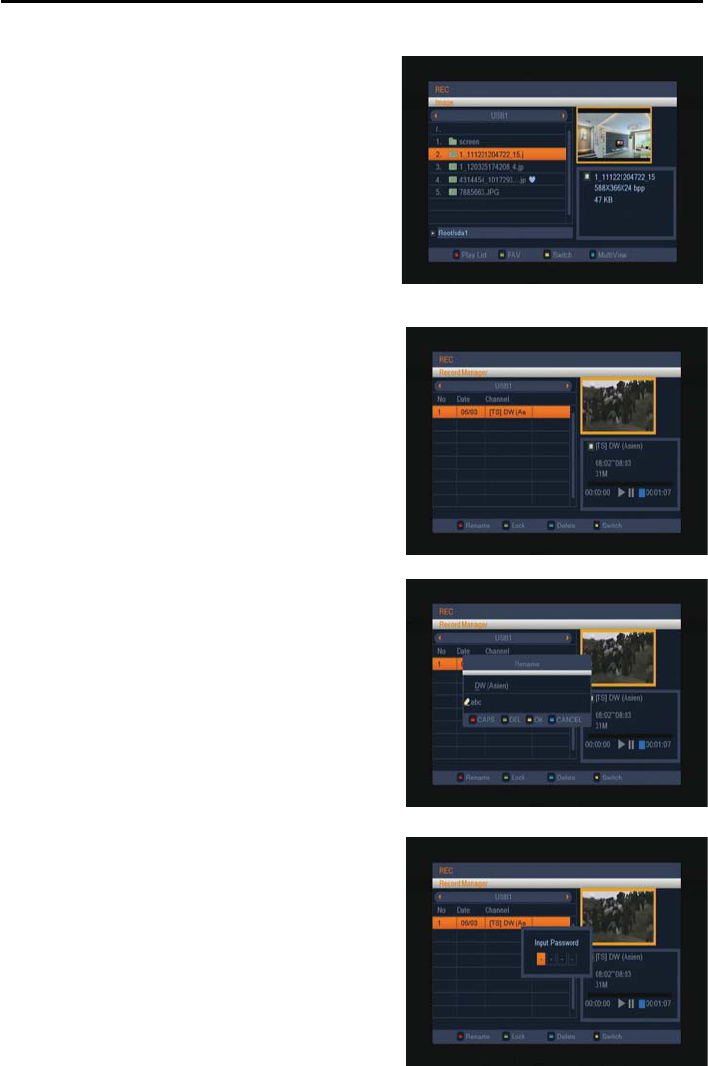
30
Menu Operations
6.4.2 All
1. Press [VOL◄/►] select the all, mp3, image,
video, music list, picture list, video list, Record
list.
2. You can move the highlighted Record with
[CH▲/▼] to preview the highlighted program in
the preview window.
3. Press [Menu] or [Exit] buttons to enter TV playing
mode.
4. The color buttons offer further functions to
manage.
6.4.3 Record Management
If you select in “Media List” with [VOL◄/►] to group
“Record list” a window like the one beside will open:
The color buttons offer further functions to manage the
list.
Rename
1. Press red button to open the “Rename” window
like showed beside. Press [CH▲/▼] / [VOL◄/►]
to select the leading character of the channel
name and press [OK] to confirm it.
2. After entering the character(s) highlight “OK” in
the window and press [OK] on the RCU.
3. Press [Exit] button to close the find window and
brings you back to the Record list.
Lock
In channel Record menu, press green button to place a
lock icon behind the name of the highlighted Record.
Marked Records will be locked and displayed only after
password has been entered if you confirm to save the
changes when you leave this menu.
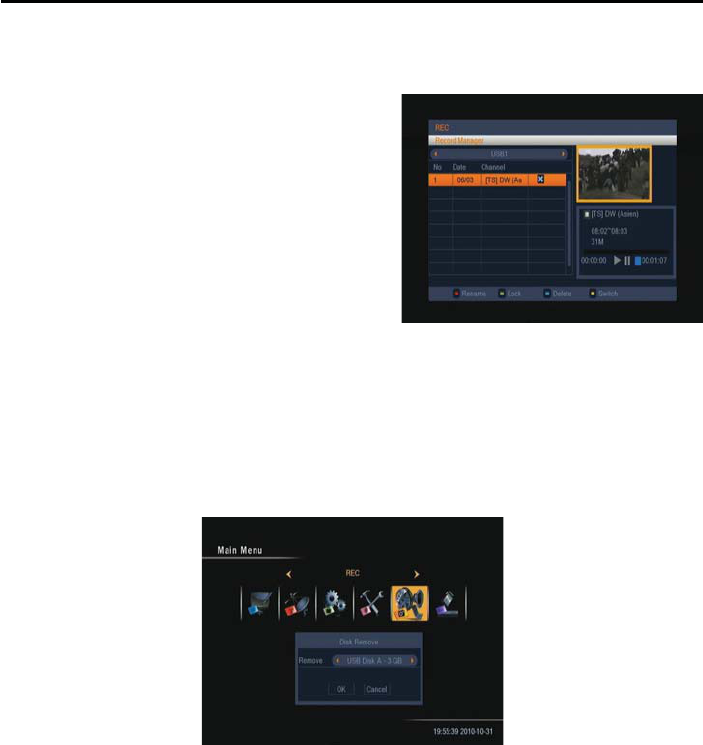
31
Menu Operations
Delete
In channel Record menu, press red button will open another window where you can choose
between add one image and add all images.
♦Del One
Press red button to mark an image for add.
Marked image will be add after you confirm to
save the changes when you leave this menu.
♦Del All
a) Press green button to show a add icon
behind all image name.
b) Press [MENU] button you will be asked
“Are you sure to save?”. Select “OK” to add all images. Select “Cancel” to cancel the
operation.
6.5 Remove USB device safely
In case you want to remove the USB device please always do this as follows:
Press [OK] to select directly with [CH▲/▼] remove to select the wanted
partition.
Press [OK] to confirm it. Press [Cancel] and [Exit] button to leave the “Remove
USB device safely” menu.
This avoids any potential data loss in case of unauthorized remove of the USB
device.
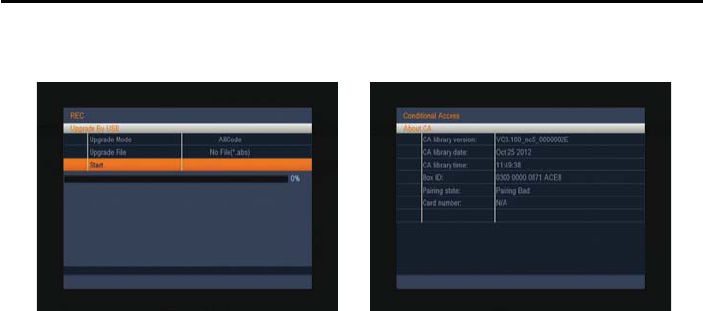
32
Menu Operations
7. Conditional Access
When you enter to “CAS” menu, you will see a screen like shown here:
Tokens Status & About CA
In this option, you can find information about the conditional access system.
Note: Card must be inserted with chip facing up.
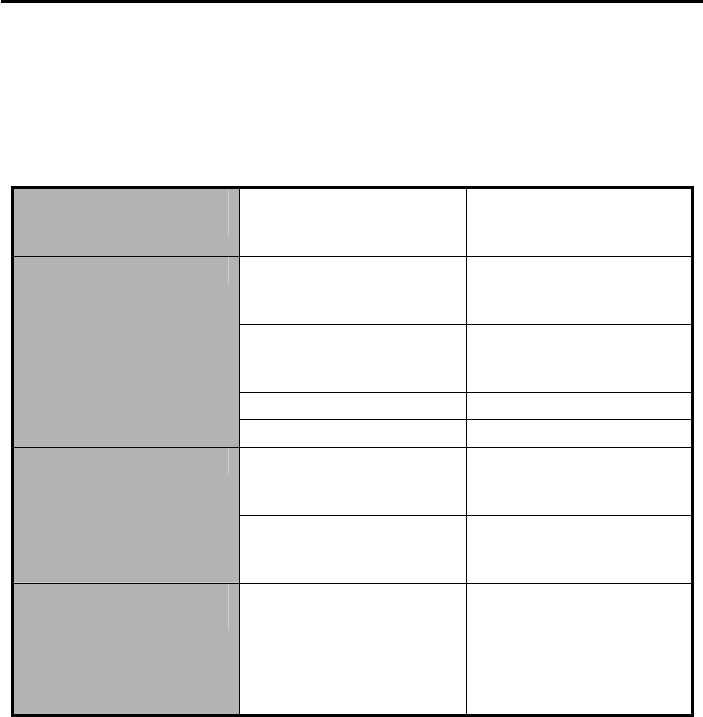
33
Menu Operations
8. Troubleshooting
There may be various reasons behind STB problems. Check the STB according to the procedures
described below. If you can’t solve your problem even after following the troubleshooting procedures,
please contact the dealer. Do not open the STB cover; it may cause a dangerous situation.
The front panel doesn’t
display any message
The power cord is not
plugged in.
Check that the power cable
is plugged in to the wall
outlet and the STB.
Wrong connection of the
audio / video output of the
STB to TV.
Connect the audio / video
output of the STB to TV
correctly.
No or bad signal message
appears.
Check other device
connected between cable
connection and the STB.
Audio muting Press the MUTE button.
No picture or sound
TV power Turn TV on.
The STB can’t receive the
signal.
Check the cable, replace the
cable or connect the cable to
the STB tightly.
No picture
Incorrect values of some
tuner parameters.
Set the values of tuner
parameters correctly. Refer
to the installation menu.
The remote control does not
operate
The batteries of the remote
control are not inserted or
exhausted.
Check whether the batteries
are inserted correctly in your
remote control.
Check and replace the
batteries of the remote
control.

34
Technical Specification
Technical Specification
SYSTEM
CPU ALI_M3603
DDRAM 128MByte
Flash 8MByte
DECODING
Video Decoder MPEG4 compliant support SP@L3 to
ASP@L5, MPEG2 MP@HL,MPEG1
Decoding Format NTSC/PAL
Aspect Ratio 4:3,16:9,AUTO Resolution(CVBS)
720x480(NTSC),720x576(PAL) Resolution(HDMI)
SD:
720x480 @ 30fps; 720x576 @ 25fps
HD: 480p, 576p, 720i, 720p, 1080i
Audio Decoding MPEG Musicam Layer 1 & 2
Audio Modes Mono / Left / Right / Stereo
TUNER
RF Input Range 54MHz ~ 864MHz
Sensitivity -5dBm ~ -83dBm
Input Connector F-type, female, 75Ohm
Demodulation 8/16-VSB, ITU-T J.83 AnnexB
64/256QAM. Payload Data Rate 19.4 Mbps (6MHz)
RF MODULATOR
Output Channel CH3 - 4
TV Standards NTSC-M
RF Connector F-type, female, 75Ohm
FRONT PANEL
Display 4-digi-LED display
Buttons 7: Standby,CH+,CH-,VOL+,VOL-,MUEN,OK
Connector
RCA 1 RCA/Cinch for VIDEO:CVBS
2 RCA/Cinch for
AUDIO(L/R) HDMI A Type, compliant HDMI
1.3
OPTICAL S/PDIF

35
Technical Specification
USB A Type, USB2.0
Smart Card Verimatrix
POWER SUPPLY
Type Switching Mode
Input Voltage 100 to 240V,50/60Hz
Consumption max. 15W
Protection Internal
Fuse
PHYSICAL SPECIFICATION
Size (W x H x
D) Net Weight
Operation Temp. 0° - 40°C
Storage Temp. -20° -
60°C